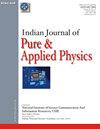LBSO/CuI作为钙钛矿太阳能电池有效ETL/HTL的适用性:干法实验室方法
IF 1.1
4区 物理与天体物理
Q4 PHYSICS, MULTIDISCIPLINARY
引用次数: 0
摘要
随着功率转换效率(PCE)的快速突破,基于混合卤化物钙钛矿(HHPs)的太阳能电池被认为是下一代太阳能电池技术的潜在候选者。然而,这些钙钛矿太阳能电池(PSCs)仍然远离光伏市场的大门,因为它们在制造过程中涉及到各种使用材料的不稳定性问题。在这项工作中,我们使用SCAPS-1D软件对PSC器件进行数值模拟。为了获得更好的性能,人们提出了几种突出的吸收层材料,即la掺杂BaSnO3作为ETL和CuI作为HTL的组合。适当的ETL、吸收层和HTL对器件整体性能有很强的依赖性。此外,基于fapbi3的器件优于其他具有不同吸收材料的器件,总体PCE为22.09%。因此,使用计算机模拟的干实验室方法将有助于实验者通过减少实验试验的成本来设计和制造类似的psc。本文章由计算机程序翻译,如有差异,请以英文原文为准。
Suitability of LBSO/CuI as an Effective ETL/HTL for Perovskite Solar Cells: A Dry Lab Approach
With rapid breakthroughs in power conversion efficiency (PCE), hybrid halide perovskites (HHPs) based solar cells have been considered as the potential candidates for the next generation solar cell technology. However, these perovskite solar cells (PSCs) are still far from the door of the photovoltaic market owing to their instability issue involved with various used materials during fabrication. In this work, we deal with the numerical simulation of PSC devices via SCAPS-1D software. For better performance, several prominent materials for absorber layer have been proposed with a combination of La-doped BaSnO3 as ETL and CuI as HTL. The strong dependency of proper ETL, absorber layer and HTL on the overall device performance has been observed. Moreover, the FAPbI3-based device outperformed other devices with different absorber materials, yielding an overall PCE of 22.09 %. Thus, the dry lab approach using computer simulations will be helpful for experimentalists to design and fabricate similar PSCs by reducing the cost of experimental trials.
求助全文
通过发布文献求助,成功后即可免费获取论文全文。
去求助
来源期刊
CiteScore
1.30
自引率
14.30%
发文量
42
审稿时长
7 months
期刊介绍:
Started in 1963, this journal publishes Original Research Contribution as full papers, notes and reviews on classical and quantum physics, relativity and gravitation; statistical physics and thermodynamics; specific instrumentation and techniques of general use in physics, elementary particles and fields, nuclear physics, atomic and molecular physics, fundamental area of phenomenology, optics, acoustics and fluid dynamics, plasmas and electric discharges, condensed matter-structural, mechanical and thermal properties, electronic, structure, electrical, magnetic and optical properties, cross-disciplinary physics and related areas of science and technology, geophysics, astrophysics and astronomy. It also includes latest findings in the subject under News Scan.

 求助内容:
求助内容: 应助结果提醒方式:
应助结果提醒方式:


